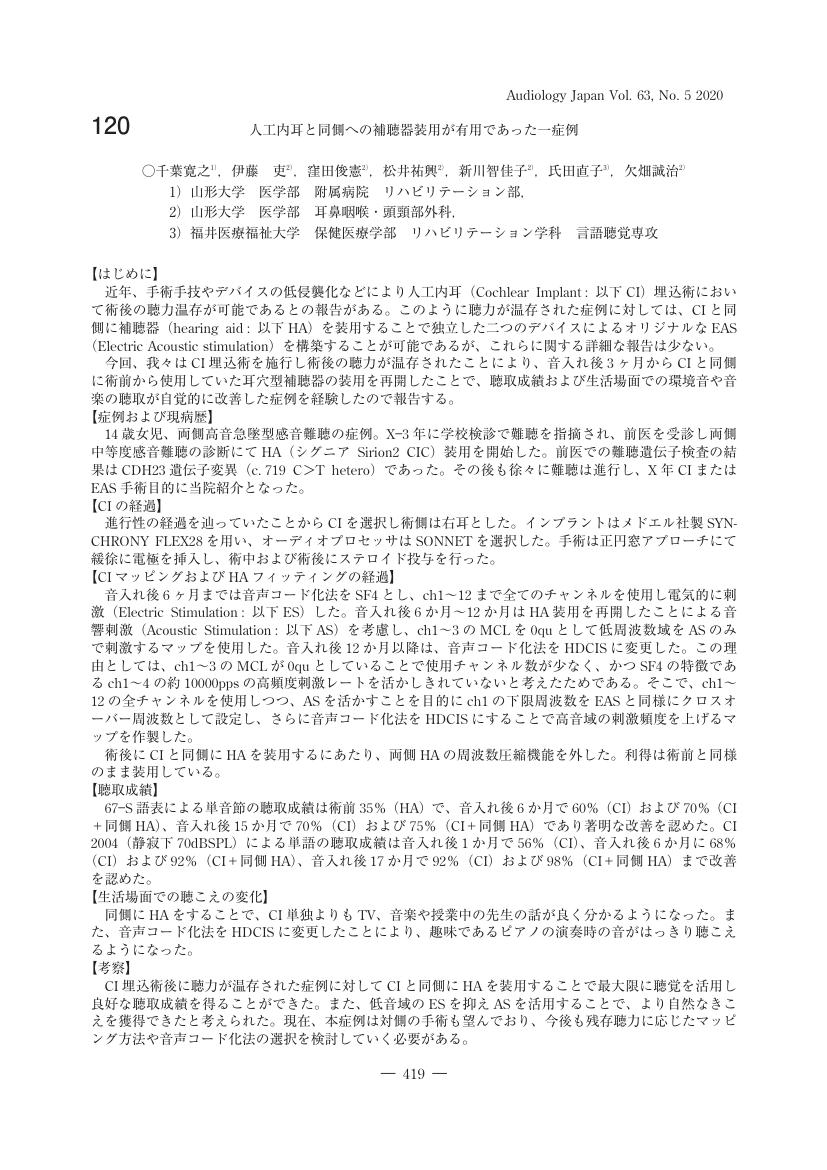7 0 0 0 OA 突発性難聴に対するステロイド大量・PGE1併用療法の早期治療開始による効果
- 著者
- 窪田 俊憲 渡辺 知緒 横田 雅司 伊藤 吏 青柳 優
- 出版者
- 一般社団法人 日本耳鼻咽喉科頭頸部外科学会
- 雑誌
- 日本耳鼻咽喉科学会会報 (ISSN:00306622)
- 巻号頁・発行日
- vol.115, no.5, pp.540-545, 2012 (Released:2012-09-06)
- 参考文献数
- 17
- 被引用文献数
- 2 2
突発性難聴に対してステロイド大量・PGE1併用療法を早期に開始することによる治療効果への影響を検討するために, 発症から7日以内に同治療を開始した174例の突発性難聴症例を解析した. 「治癒」「著明回復」「回復」を合わせて「改善」,「不変」を「非改善」として, 改善の有無と治療開始までの期間, 年齢, 初診時聴力レベル, めまいの訴えの有無の4因子との関連を多重ロジスティック回帰分析で検討した. その結果, 治療開始までの期間および年齢と改善の有無との間に有意な関連が認められた. すなわち, 治療開始までの期間が短いほど, 年齢が若いほど治療効果が高くなるという結果であった. 治療開始までの期間による治療効果の検討では, 発症3日以内に治療を開始した症例の治療効果が, 発症4~7日に治療を開始した症例よりも高かった (p<0.01). 50歳未満の症例では, 発症3日以内に治療を開始した症例の治療効果は, 発症4~7日に治療を開始した症例と比較して有意な差を認めなかった. これに対して, 50歳以上の症例では, 発症3日以内に治療を開始した症例の治療効果が, 発症4~7日に治療を開始した症例と比較して高かった (p<0.01). 突発性難聴に対するステロイド大量・PGE1併用療法では, 発症7日以内よりも早期に, 特に, 50歳以上の症例では発症3日以内に治療を開始することで, より高い治療効果が得られるものと考えた.
6 0 0 0 OA ヘリカルCTが有用であった頸部木片異物例
- 著者
- 那須 隆 小池 修治 鈴木 豊 伊藤 吏 岡崎 慎一 野田 大介 青柳 優
- 出版者
- 耳鼻咽喉科臨床学会
- 雑誌
- 耳鼻咽喉科臨床 (ISSN:00326313)
- 巻号頁・発行日
- vol.97, no.9, pp.819-824, 2004-09-01 (Released:2011-10-07)
- 参考文献数
- 25
- 被引用文献数
- 6 4
A 1-year-and-1-month-old boy presented with a wooden foreign body in a right cervical lesion after falling down. The foreign body was the broken tip of a wooden chopstick which was penetrating into his neck. No foreign bodies were reliably detected by plain film. We then used helical CT for the diagnosis of the foreign body. A wooden foreign body, 2.2cm long and 2mm in diameter, like a rod, was shown embedded in his neck by reconstructing 3D images of helical CT. The wooden foreign body was removed through an incision of the neck under general anesthesia.In this case, helical CT was helpful in the diagnosis of a radiolucent wooden foreign body in a cervical lesion.
3 0 0 0 OA 骨導聴力検査と骨導DPOAEによる骨導音の伝達に関する検討
- 著者
- 渡辺 知緒 伊藤 吏 阿部 靖弘 千葉 寛之 青柳 優
- 出版者
- 一般社団法人 日本聴覚医学会
- 雑誌
- AUDIOLOGY JAPAN (ISSN:03038106)
- 巻号頁・発行日
- vol.50, no.5, pp.465-466, 2007-09-05 (Released:2010-08-05)
2 0 0 0 OA 聴性定常反応の閾値に対する背景ノイズの影響
- 著者
- 伊藤 吏 渡辺 知緒 阿部 靖弘 窪田 俊憲 千葉 寛之 青柳 優
- 出版者
- 日本聴覚医学会
- 雑誌
- AUDIOLOGY JAPAN (ISSN:03038106)
- 巻号頁・発行日
- vol.51, no.5, pp.481-482, 2008-09-05 (Released:2010-08-05)
1 0 0 0 OA 多能性幹細胞Muse細胞を用いた蝸牛有毛細胞再生
4~8kHzのバンドノイズを130dBの大きさで3時間モルモットに暴露することにより、持続的な高度難聴を示す内耳障害モデルの作製した。この内耳障害モデルに、障害翌日にマイクロカテーテルを用いてMuse細胞の移植を行った。10,000細胞移植した群では、移植後6週から12週まで、4kHzと8kHzにおいて、コントロール群に比べて、有意に聴力の回復を認めた。また移植後12週の時点で外有毛細胞の消失率を検討したところ、8kHzの担当周波数領域において、対象群ではコントロールに比べ有意に外有毛細胞の消失率が低いことが判明した。現在はMuse細胞のコルチ器への遊走や生着について検討中である。
1 0 0 0 OA 上半規管裂隙症候群と機能的輻輳痙攣が合併した一症例
- 著者
- 渡邊 千尋 大和田 聡子 伊藤 吏 村上 信五 欠畑 誠治
- 出版者
- 一般社団法人 日本めまい平衡医学会
- 雑誌
- Equilibrium Research (ISSN:03855716)
- 巻号頁・発行日
- vol.78, no.3, pp.178-184, 2019-06-30 (Released:2019-08-02)
- 参考文献数
- 15
Herein, we present a patient with superior semicircular canal dehiscence syndrome (SCDS) manifesting as convergence spasms, which were alleviated by canal plugging surgery. SCDS is described in the literature by Minor as “a condition characterized by vertigo and oscillopsia induced by loud sounds or changes in the pressure of the external auditory canal or middle ear due to the dehiscence of the bone overlying the superior semicircular canal.” Convergence spasms are characterized by intermittent sustained convergence, accommodative spasms and miosis, and are likely to be caused by a functional disease, although in some cases, it is a manifestation of an organic disease. A 49-year-old male patient visited our department with a 2-year history of intermittent sudden vertigo and cloudy vision. The vertigo attacks had gradually increased in frequency and could last all day. Pure-tone audiometry showed bilateral conductive hearing impairment with air-bone gap at low frequencies from 125Hz to 500Hz. A head CT showed bone dehiscence above the bilateral superior semicircular canals and tegmen of the epitympani. Initial equilibrium testing did not reveal any abnormal findings. Initial sono-ocular testing of the right ear indicated upbeat nystagmus. However, after multiple outpatient visits, the upbeat nystagmus disappeared during the sono-ocular test and was replaced by paradoxical convergence. The eye tracking test also revealed paradoxical convergence, which became frequent and was accompanied by pupillary miosis. This paradoxical convergence was ultimately diagnosed as convergence spasms. No improvement of symptoms was achieved through non-surgical treatments over an extended period of time, therefore, canal plugging surgery was recommended. The surgery was performed through a middle fossa approach, and it completely eliminated the cochlear and vestibular symptoms associated with SCDS and the convergence spasms. Finally, we suspected that the convergence spasms were caused by ocular dysfunction as well as neurological factors related to the SCDS.
1 0 0 0 OA 人工内耳と同側への補聴器装用が有用であった一症例
- 著者
- 千葉 寛之 伊藤 吏 窪田 俊憲 松井 祐興 新川 智佳子 氏田 直子 欠畑 誠治
- 出版者
- 一般社団法人 日本聴覚医学会
- 雑誌
- AUDIOLOGY JAPAN (ISSN:03038106)
- 巻号頁・発行日
- vol.63, no.5, pp.419, 2020-09-30 (Released:2020-11-10)


